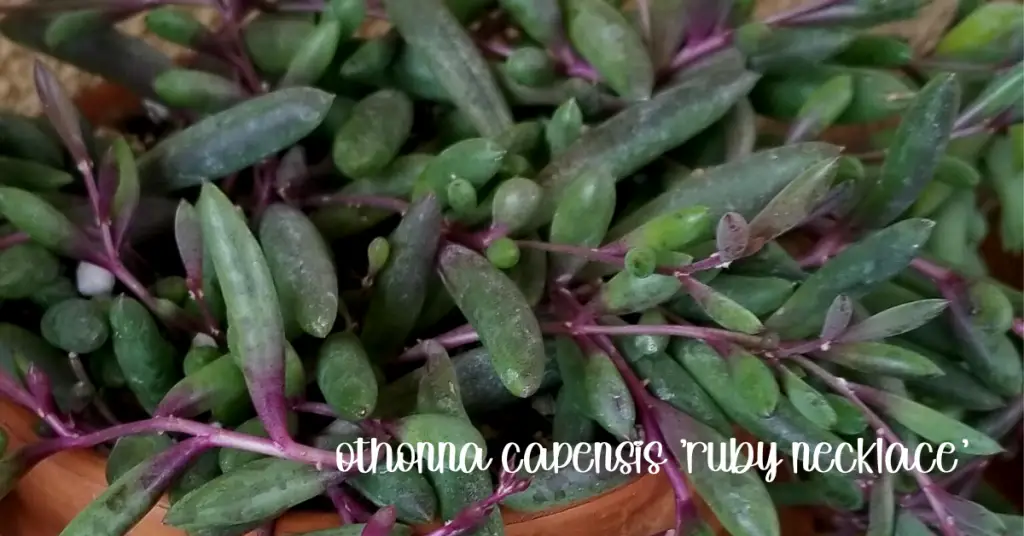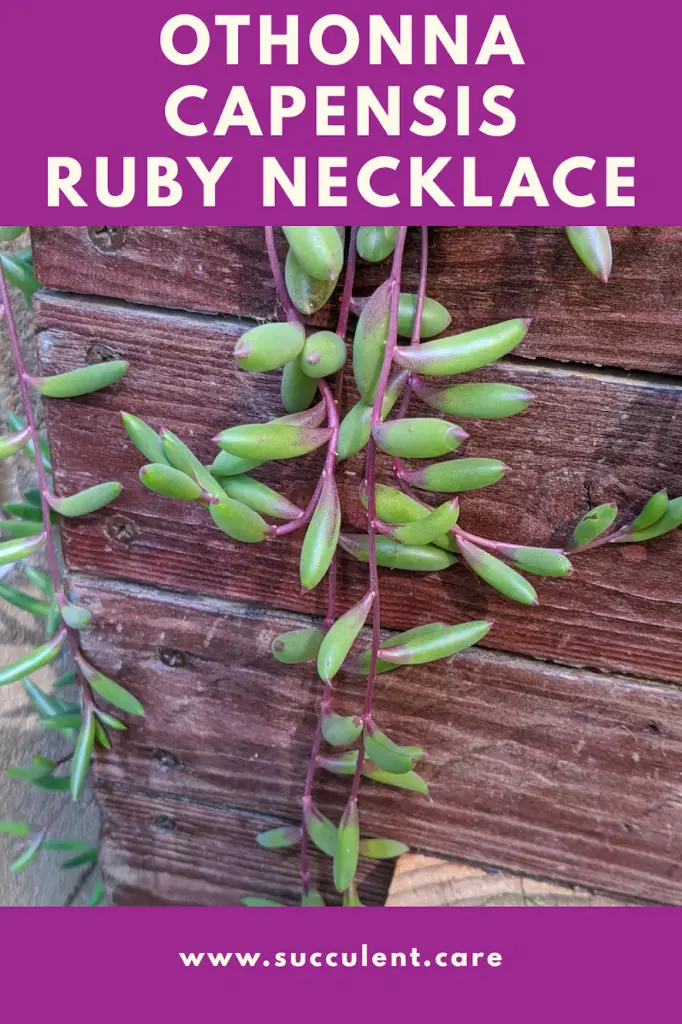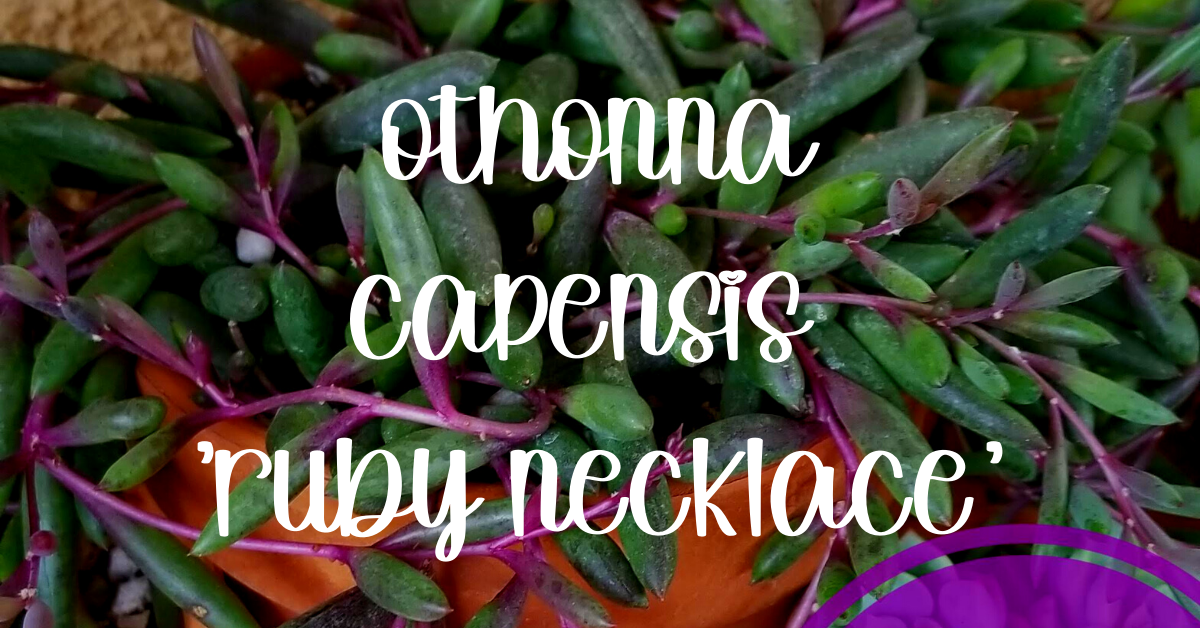If you’re a fan of succulent plants, you’ll want to add Othonna capensis ‘Ruby Necklace’ to your collection. This striking plant is known for its vibrant red and green leaves, which form a necklace-like pattern around the stem. In this post, we’ll explore the care requirements for Othonna capensis ‘Ruby Necklace’, as well as some tips for keeping this plant healthy and happy.

What is Othonna capensis ‘Ruby Necklace’?
Othonna capensis ‘Ruby Necklace’ is a beautiful trailing succulent native to South Africa. It belongs to the Asteraceae family, also known as the sunflower family, though it does not produce sunflower-like blooms. Othonna capensis is prized for its striking foliage, not its flowers.
The leaves of ‘Ruby Necklace’ grow in an alternating pattern along thin purple stems, forming a delicate cascade of teardrop-shaped foliage. The unique feature that gives this succulent its name is the necklace-like pattern circling each leaf. The top half of each leaf is a deep reddish purple, while the bottom half is a bright green, creating a two-toned effect that resembles a string of beads around the leaf.
This unusual and eye-catching foliage makes ‘Ruby Necklace’ a top choice for succulent enthusiasts and decorative gardeners. It looks stunning spilling over the edges of containers or garden beds. Despite their delicate appearance, the stems of ‘Ruby Necklace’ are quite hardy. This succulent is easy to grow and propagates readily from stem cuttings. It thrives in bright light and well-draining soil, only needing moderate watering when the soil is dry. If given the proper conditions, ‘Ruby Necklace’ will flourish and provide long-lasting interest with its dazzling, jewel-toned foliage.
How to Care for Othonna capensis ‘Ruby Necklace’
Othonna capensis ‘Ruby Necklace’ is a relatively easy plant to care for, making it a great choice for beginners and experienced gardeners alike. Here are some quick and easy tips for keeping this plant happy and healthy:
- Light Requirements:
- Othonna capensis ‘Ruby Necklace’ thrives in bright, indirect light. A south- or west-facing window is typically a good location for this plant. Avoid placing it in direct sunlight, as this can cause the leaves to fade or burn.
- To get your ‘Ruby Necklace’ leaves to get that beautiful stressed purple color, withhold water and make sure it gets lots of sunlight. You’ll see exactly why this beauty scored its nickname.
- Soil Requirements:
- As mentioned above, it’s important to use a gritty, mostly inorganic, well-draining soil mix for Othonna capensis ‘Ruby Necklace’. A cactus or succulent mix is a good choice. You can also mix in some additional gritty soil amendments such as pumice or Turface MVP to further ensure your soil drains adequately.
- Fertilizer:
- ‘Ruby Necklace,’ like most other succulents, does not typically require fertilizer. However, if you want to give your plant a boost, you should fertilize it no more than once a month during the growing season (spring and summer) using a balanced fertilizer diluted to half strength. Using your preferred fertilizer at full strength can cause chemical burns.
- This plant is not tolerant of frost, so it is important to protect it from cold temperatures. In general, ‘Ruby Necklace’ is best suited to USDA planting zones 10 and 11, which have warm, frost-free winters.
How often should I water my ‘Ruby Necklace’ plants?
Othonna capensis ‘Ruby Necklace’ should be watered sparingly but thoroughly when the soil is dry. As a general rule, allow the top few inches of soil to dry out between waterings. Then, water your ‘Ruby Necklace’ until water flows out the drainage holes at the bottom of the pot.
The exact frequency of watering will depend on factors like light levels, temperature, and pot size. ‘Ruby Necklace’ plants in brighter light or warmer temperatures may need water more often, while those in smaller pots will dry out more quickly. It’s best to check the soil before each watering to ensure you’re not overwatering or underwatering your succulent.
Overwatering can lead to root rot in ‘Ruby Necklace’, so it’s important not to leave the plant sitting in water or keep the soil constantly moist. Better to water sparingly but thoroughly when needed than to keep the soil mostly wet. With some practice, you’ll get a feel for how often your particular ‘Ruby Necklace’ needs water based on how quickly the soil dries out.
What type of soil should I use to repot my ‘Ruby Necklace’?
For Othonna capensis ‘Ruby Necklace’, it’s best to use a fast-draining cactus potting mix or succulent soil. These mixes contain ingredients like perlite, pumice, and/or grit that help with drainage and airflow around the roots. You can also make your own succulent soil by mixing two parts potting soil with one part perlite or coarse sand.
Whatever soil you choose, be sure it drains quickly and doesn’t hold too much moisture. ‘Ruby Necklace’ is prone to root rot if the soil is constantly wet, so good drainage is key. A well-draining soil will help ensure your succulent gets the aeration it needs around the roots, while still retaining enough moisture for the plant to grow and thrive. With the proper soil, your ‘Ruby Necklace’ should stay healthy and continue to delight you with its dazzling necklace-like leaves.
Should I add any fertilizer to the soil?
Othonna capensis ‘Ruby Necklace’ does not typically require fertilizer to thrive. As a succulent, it is well adapted to grow in relatively low-nutrient soils. However, if you want to give your plant a boost or encourage more growth, you can fertilize during the growing season. Use a balanced fertilizer diluted to 1/2 the recommended strength and apply it sparingly, no more than once a month. Be sure not to overfeed, as too much fertilizer can damage succulents.
Many succulent growers do not fertilize at all, and ‘Ruby Necklace’ should do fine without it if provided with adequate light, water, and soil. However, light fertilizing can be beneficial if done properly and according to the needs of your individual plant. As always, it’s best to underwater rather than overfeed, so apply fertilizer conservatively if at all.

How to Propagate Othonna capensis ‘Ruby Necklace’
- To propagate the dazzling ‘Ruby Necklace’ succulent, you’ll first need to obtain some stem cuttings from a healthy, mature plant. Select 4-6 inch stems that have leaves only at the tip, and remove any lower leaves. Let the cut ends dry out for a couple days so the open tissue can heal and callus over.
- Once the cut ends have dried, it’s time to root the cuttings. Dip them in rooting hormone for a boost, if desired, then plant in well-draining potting mix. Cover the cuttings with a plastic bag to maintain humidity, and place them in a bright spot out of direct sun. Keep the soil moderately moist and temperatures warm.
- In a month or so, check for new roots emerging from the callused ends of the cuttings. Once a healthy root system has developed, your new ‘Ruby Necklace’ plants will be ready to pot up or plant outside. With the right conditions and a dose of patience, you’ll have gorgeous new succulents to show for your efforts. Propagating your own plants can be very rewarding, and ‘Ruby Necklace’ is an easy and striking subject to start with.
‘Ruby Necklace’ is a stunning succulent plant that is sure to add a touch of beauty to your collection. With its vibrant reddish purple and green leaves and easy care requirements, it’s a great choice for gardeners of all levels. By providing it with bright, indirect light, watering it properly, and using a well-draining soil mix, you can help ensure that your Othonna capensis ‘Ruby Necklace’ stays healthy and happy for years to come.

Where to Buy Succulents Online



